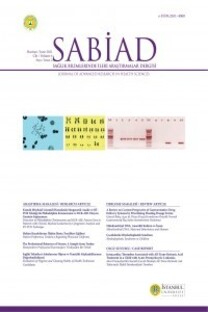Pediatrik tromboza multidisipliner yaklaşım, üçüncü basamak referans merkezin 2 yıllık deneyimi
Pediatrik tromboz, tedavi, proflaksi, multidisipliner yönetim
Two years experience of a multidisciplinary approach for pediatric thrombosis in a tertiary referral center
Pediatric thrombosis, treatment, prophylaxis, multidisciplinary management,
___
- 1. Monagle P, Cuello CA, Augustine C, Bonduel M, Brandao LR, et al. American Society of Hematology 2018 Guidelines for management of venous thromboembolism: treatment of pediatric venous thromboembolism. Blood advances. 2018;2(22):3292-316.
- 2. Newall F, Branchford B, Male C. Anticoagulant prophylaxis and therapy in children: current challenges and emerging issues. Journal of thrombosis and haemostasis : JTH. 2018.
- 3. Chalmers E, Ganesen V, Liesner R, Maroo S, Nokes T, et al. Guideline on the investigation, management and prevention of venous thrombosis in children. British journal of haematology. 2011;154(2):196-207.
- 4. Young G, Albisetti M, Bonduel M, Brandao L, Chan A, et al. Impact of inherited thrombophilia on venous thromboembolism in children: a systematic review and metaanalysis of observational studies. Circulation. 2008;118(13):1373-82.
- 5. Mahajerin A, Branchford BR, Amankwah EK, Raffini L, Chalmers E, et al. Hospital-associated venous thromboembolism in pediatrics: a systematic review and meta-analysis of risk factors and risk-assessment models. Haematologica. 2015;100(8):1045-50.
- 6. Jaffray J, Mahajerin A, Young G, Goldenberg N, Ji L, et al. A multi-institutional registry of pediatric hospital-acquired thrombosis cases: The Children’s Hospital-Acquired Thrombosis (CHAT) project. Thrombosis research. 2018;161:67-72.
- 7. Monagle P. Slow progress. How do we shift the paradigm of thinking in pediatric thrombosis and anticoagulation? Thrombosis research. 2019;173:186-90.
- 8. Monagle P, Chan AKC, Goldenberg NA, Ichord RN, Journeycake JM, et al. Antithrombotic therapy in neonates and children: Antithrombotic Therapy and Prevention of Thrombosis, 9th ed: American College of Chest Physicians EvidenceBased Clinical Practice Guidelines. Chest. 2012;141(2 Suppl):e737S-e801S.
- 9. Rodger MA, Le Gal G. Who should get long-term anticoagulant therapy for venous thromboembolism and with what? Blood advances. 2018;2(21):3081-7.
- 10. Nowak-Gottl U, van Ommen H, Kenet G. Thrombophilia testing in children: What and when should be tested? Thrombosis research. 2018;164:75-8.
- Yayın Aralığı: Yılda 3 Sayı
- Başlangıç: 2018
- Yayıncı: İstanbul Üniversitesi
Radyolojik bulgularla submandibular bezde dev siyalolit: Olgu sunumu
Sedef Ayşe TAŞYAPAN, Ahmet Faruk ERTÜRK, İlknur ÖZCAN
Sevde HASANOĞLU, Beyza GÖNCÜ, Emrah YÜCESAN
Taraxacum farinosum Hausskn. & Bornm. bitkisinin antioksidan aktivite yönünden incelenmesi
Aynur SARI, Nurten ÖZSOY, Seçil KARAHÜSEYİN
Taraxacum farinosum Hausskn. & Bornm. bitkisinin antioksidan aktivite yönünden incelenmesi
Aynur SARI, Nurten ÖZSOY, Seçil KARAHÜSEYİN
Pediatrik tromboza multidisipliner yaklaşım, üçüncü basamak referans merkezin 2 yıllık deneyimi
Rumeysa TUNA, Mustafa BİLİCİ, Osman KİPOĞLU, Orhan COŞKUN, Zuhal BAYRAMOĞLU, Suheyla OCAK, Deniz TUĞCU, Serap KARAMAN, Ayşegül ÜNÜVAR, Serra SENCER, Nur AYDINLI, Zerrin ÖNAL, Zeynep YÜRÜK YILDIRIM, Kemal NİŞLİ, Rukiye EKER ÖMEROĞLU, Aygün DİNDAR, Zeynep İNCE, Demet DEMİRKOL, Mine ÇALIŞKAN, Zeynep KARAKAŞ
